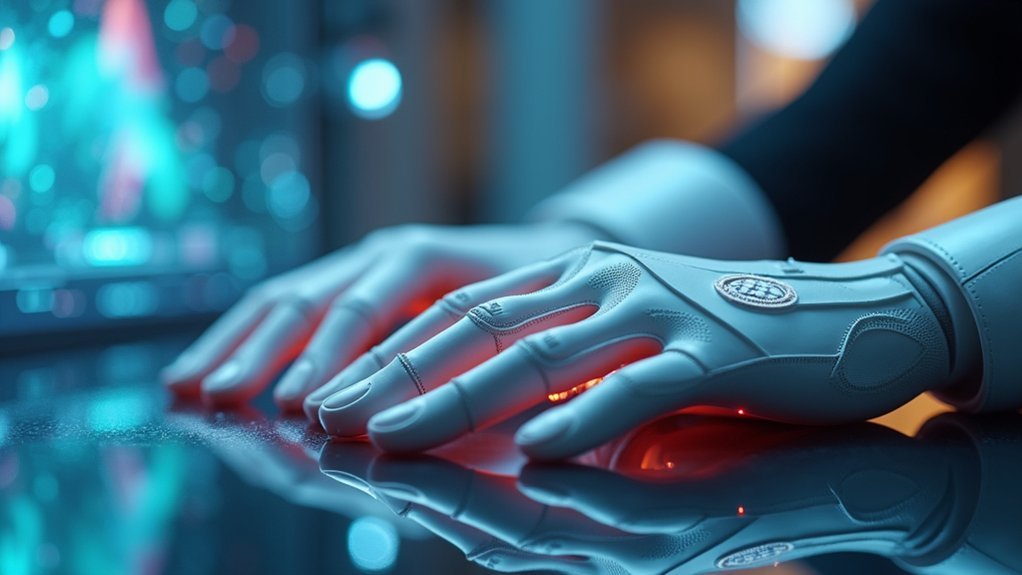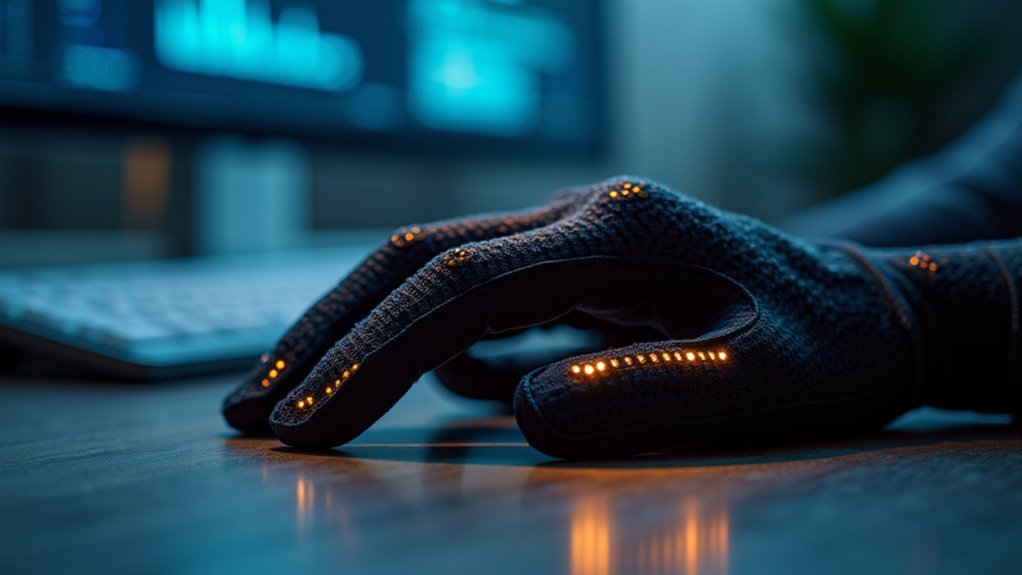You’ll feel virtual objects as if they’re real because wireless haptic gloves use over 100 tactile actuators that create precise pressure, texture, and resistance sensations. They combine force feedback systems generating up to 20N of resistance with temperature simulation through Peltier devices, vibrotactile feedback for surface textures, and real-time motion tracking. Low-latency wireless communication under 20 milliseconds guarantees immediate responses, while advanced algorithms optimize each sensation based on virtual object properties to trick your brain into experiencing authentic touch.
Advanced Haptic Technology Behind the Sensation

When you slip on wireless haptic gloves, you’re experiencing the culmination of sophisticated actuators and sensors working in perfect harmony to deliver real-time tactile feedback that convincingly mimics touching virtual objects.
These devices combine force feedback, vibrotactile sensations, and pressure to create realistic resistance and impact. You’ll feel varying textures and shapes through high-density actuator arrays, though current technology still struggles with fine texture distinctions.
The wireless design eliminates latency while boosting your mobility, letting you interact naturally with virtual spaces.
Advanced algorithms and machine learning optimize sensation simulation, ensuring feedback accurately corresponds to your actions and virtual object properties.
This technological symphony transforms simple hand movements into immersive experiences that blur the line between digital and physical reality.
How Air Pockets and Actuators Create Touch
You’ll find that wireless haptic gloves create realistic touch sensations through sophisticated air pressure systems that inflate and deflate tiny pockets called tactors across your fingertips and palm.
These gloves pack over 100 tactile actuators into each hand covering, giving you incredibly detailed feedback that can simulate everything from a feather’s lightness to a rock’s firmness.
The pneumatic touch simulation works by precisely controlling air flow through miniature valves, allowing you to feel virtual objects’ weight, texture, and resistance as if they were physically present.
Air Pressure Systems
At the heart of wireless haptic gloves lies an intricate network of air pressure systems that transform digital interactions into tangible sensations. Your VR glove utilizes dozens of strategically placed tactors that inflate and deflate in milliseconds, creating realistic resistance as you grasp virtual objects. The system’s precision allows for subtle pressure variations that distinguish between a feather’s touch and a firm handshake while maintaining your natural range of motion.
| Pressure Level | Sensation Type | Virtual Object Example |
|---|---|---|
| Low (5-15 PSI) | Light Touch | Butterfly, Silk Fabric |
| Medium (16-30 PSI) | Moderate Grip | Tennis Ball, Paperback Book |
| High (31-45 PSI) | Firm Resistance | Rock, Metal Tool |
| Variable | Temperature | Ice Cube, Warm Surface |
| Pulsed | Texture | Sandpaper, Velvet |
This dynamic control guarantees immediate, natural feedback that makes virtual interactions feel authentically real.
Tactile Actuator Density
Over 100 miniature air pockets work in concert across your glove’s surface, creating a sophisticated tactile matrix that translates digital code into physical sensation.
These haptic actuators form a dense network that delivers precise feedback, making virtual reality interactions feel remarkably authentic.
The concentration of these tactors determines how convincingly you’ll experience virtual objects:
- Texture simulation – Dense actuator arrays create the rough bark of a tree or smooth marble surface
- Weight distribution – Multiple pressure points simulate holding a heavy virtual hammer or delicate feather
- Temperature illusion – Coordinated actuator responses mimic the warmth of sunlight or coolness of metal
Higher actuator density means more detailed sensations.
You’ll distinguish between different materials, feel object edges clearly, and experience subtle environmental changes that bridge the gap between digital and physical worlds.
Pneumatic Touch Simulation
When you press your finger against a virtual surface, compressed air chambers within the glove’s fabric inflate instantly, pushing back against your skin with calculated force.
This pneumatic touch simulation creates remarkably realistic tactile experiences through over 100 independently controlled inflatable actuators positioned throughout each glove.
These air pockets adjust pressure dynamically as you interact with virtual objects, delivering sensations from delicate touches to firm resistance.
You’ll feel a spider’s light footsteps or experience the solid weight of grasping a virtual hammer.
The actuators replicate an object’s shape, weight, and texture by varying inflation patterns across your hand’s surface.
Advanced control mechanisms guarantee minimal latency, making virtual interactions feel natural and immediate.
This sophisticated pneumatic system transforms abstract digital environments into tangible experiences you can genuinely feel.
Motion Tracking and Sensor Integration
You’ll find that wireless haptic gloves achieve real-time hand positioning through sophisticated inertial measurement units and optical sensors that track every finger movement with remarkable precision.
These systems excel at multi-sensor data fusion, combining flex sensors, capacitive touch sensors, and motion trackers to create a thorough picture of your hand’s position and gestures.
This integrated approach guarantees you’re getting accurate feedback whether you’re grasping virtual objects or performing complex hand movements in your VR environment.
Real-Time Hand Positioning
The foundation of wireless haptic gloves lies in their sophisticated motion tracking systems that capture every nuance of your hand movements with remarkable precision. These systems utilize advanced IMUs and optical sensors to translate your physical gestures into virtual interactions, creating seamless real-time communication between your hands and VR and AR environments.
The integration process involves three critical components:
- Flexible sensors embedded throughout the glove fabric that detect finger joint angles and palm positioning
- Lightweight motion units that track spatial orientation and acceleration patterns
- Advanced processing algorithms that convert raw sensor data into accurate digital representations
With response times achieving 10 milliseconds, you’ll experience virtually instantaneous feedback that maintains the illusion of genuine interaction with digital objects, making virtual environments feel remarkably tangible.
Multi-Sensor Data Fusion
Precision emerges when multiple sensor technologies work in concert to decode your hand’s complex movements. Multi-sensor data fusion combines accelerometer readings with gyroscope and magnetometer data, creating a thorough picture of your hand’s position and orientation.
This integration eliminates individual sensor limitations while boosting overall accuracy and responsiveness.
When you reach for a virtual tool during VR training, advanced algorithms process this fused data stream to translate your natural movements into precise virtual actions. The system continuously updates sensor information, reducing latency in haptic feedback and ensuring seamless interactions.
This real-time processing creates intuitive experiences where your hands naturally control virtual objects, making complex training scenarios feel authentic and responsive to your every gesture.
Force Feedback Mechanisms in Action

When you slip on wireless haptic gloves, magnetic friction brakes immediately spring into action, generating up to 20N of force feedback that transforms your virtual interactions into tangible experiences.
These mechanisms simulate object density and resistance, letting you feel the weight and solidity of digital items as if they’re physically present.
The technology creates realistic sensations through:
- Vibrotactile feedback – You’ll feel distinct impacts and surface textures as your fingers trace virtual objects.
- Inflatable actuators – Soft robotics technology applies pressure sensations that mimic real-world contact.
- High-density actuator arrays – Advanced systems deliver granular tactile feedback that replicates fine contours and textures.
This combination of force feedback and tactile stimulation makes virtual environments feel remarkably authentic, bridging the gap between digital and physical worlds.
Temperature Simulation and Thermal Feedback
Beyond mechanical force feedback, wireless haptic gloves incorporate thermoelectric Peltier devices that deliver authentic temperature sensations directly to your fingertips. These systems enable you to feel contextual thermal cues that dramatically enhance virtual reality immersion.
| Virtual Object | Temperature Range | Sensation Quality |
|---|---|---|
| Virtual Fire | 35-42°C | Warm/Hot |
| Ice Cube | 15-20°C | Cool/Cold |
| Metal Surface | 22-25°C | Neutral/Slight Cool |
Temperature simulation works through precise control of heating and cooling elements embedded within the glove’s fingertip regions. Current prototypes demonstrate effective thermal feedback through fixed machine setups, allowing you to experience varied sensations while interacting with virtual environments. Future developments promise enhanced temperature control systems that’ll create even more convincing and immersive virtual experiences through advanced thermal feedback mechanisms.
Vibrotactile Technology for Realistic Impact

While thermal feedback addresses temperature sensations, vibrotactile technology tackles the equally important domain of impact and texture simulation through strategically placed micro-motors throughout your haptic gloves.
These sophisticated motors generate varying frequencies and intensities, creating distinct sensations that correspond to different virtual materials and interactions.
The vibrotactile technology delivers a realistic experience through precise real-time feedback that mimics environmental interactions.
You’ll feel:
- The gentle patter of virtual raindrops hitting your fingertips
- The solid thud when your fist connects with a concrete wall
- The rumbling vibration from nearby explosions or impacts
When integrated with motion tracking, this technology creates an incredibly lifelike connection with virtual environments.
Research confirms that well-designed vibrotactile feedback greatly increases user satisfaction and presence, making your VR interactions more engaging and believable.
Wireless Communication and Low Latency Design
Since wireless haptic gloves depend entirely on seamless communication between your hands and the virtual environment, manufacturers have engineered sophisticated low-latency protocols that deliver tactile feedback in under 20 milliseconds.
This wireless communication relies on Bluetooth or proprietary protocols designed specifically for real-time responsiveness.
To achieve this low latency performance, your gloves use efficient data compression techniques that transmit essential information without compromising feedback quality.
The design incorporates lightweight materials and compact components, giving you complete freedom of movement while maintaining responsiveness.
Advanced algorithms predict your hand movements and adjust feedback accordingly, creating realistic sensations.
This precise timing guarantees that when you touch a virtual object, you’ll feel the response instantly, eliminating the disconnect that would break immersion.
Material Science and Ergonomic Engineering
Although wireless haptic gloves pack sophisticated electronics into a wearable device, their success depends on carefully selected materials that balance flexibility with durability.
Material science advances have enabled the use of flexible polymers and lightweight composites that withstand repeated use while maintaining comfort.
Modern polymer engineering delivers the perfect balance of flexibility and resilience needed for comfortable, long-lasting haptic glove performance.
Ergonomic engineering principles guarantee the glove’s design follows your hand’s natural contours, reducing strain during extended virtual reality sessions.
The integration of thoughtful material choices creates an ideal user experience:
- Breathable fabrics prevent sweat accumulation during intense gaming sessions
- Soft padding cushions pressure points where actuators contact your skin
- 3D knitted structures conform to your unique hand shape for custom-fit comfort
Advanced manufacturing techniques like injection molding enable precise placement of miniature sensors and actuators within the glove’s structure, delivering realistic haptic feedback.
Real-World Applications Driving Development
As wireless haptic gloves evolve from prototype to practical tool, industries across the spectrum are driving their development through demanding real-world applications.
You’ll find aviation and military sectors leveraging this wearable technology for high-risk training simulations, where realistic tactile feedback builds vital muscle memory safely.
Healthcare professionals practice surgical procedures virtually, experiencing authentic tissue interactions without patient risk.
Marketing teams are revolutionizing customer engagement by integrating haptic gloves into VR experiences, letting you actually touch products before purchasing.
Remote operations in hazardous environments benefit tremendously – you can operate dangerous machinery through tactile feedback while maintaining safe distance.
Research consistently shows that tactile sensations dramatically boost user immersion and satisfaction in virtual environments, making haptic feedback essential for future VR development.
Frequently Asked Questions
How Much Are the Tesla Haptic Gloves?
You can’t buy Tesla haptic gloves because they don’t exist yet. Tesla hasn’t officially released this product as of October 2023, so there’s no pricing available for these speculative devices.
What Is the Best Haptic Glove?
You’ll find HaptX Gloves are the best haptic gloves available, featuring over 100 inflatable air pockets that create incredibly realistic tactile sensations, weight simulation, and temperature feedback for unmatched virtual reality experiences.
What Are Virtual Reality Gloves?
You’ll wear virtual reality gloves as wearable devices that let you interact with digital objects through touch and haptic feedback. They use sensors for hand tracking and provide tactile sensations without traditional controllers.
How Much Do Haptic Gloves Cost?
You’ll pay anywhere from a few hundred to several thousand dollars for haptic gloves. Consumer models like SenseGlove Nova cost around $2,500, while professional HaptX gloves exceed $10,000 depending on complexity.
In Summary
You’re experiencing the future of touch through wireless haptic gloves that seamlessly blend cutting-edge technology with human sensation. When you slip them on, you’ll feel how air pockets, precise actuators, and advanced sensors work together to create convincing tactile experiences. The combination of force feedback, temperature simulation, and vibrotactile elements tricks your brain into believing you’re touching real objects. This revolutionary technology transforms how you’ll interact with digital worlds forever.





Leave a Reply